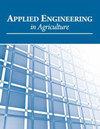Boundary-Based Rice-Leaf-Disease Classification and Severity Level Estimation for Automatic Insecticide Injection
IF 0.9
4区 农林科学
Q4 AGRICULTURAL ENGINEERING
引用次数: 0
Abstract
Highlights A rice-leaf-disease detection and classification algorithm for multiple rice-leaf-diseases in a complicated rice leaf image is proposed in this article. To increase rice-leaf-disease classification accuracy, an algorithm for coarse-to-fine determination is proposed. Since features of rice-leaf-disease types such as color, shape, and so on are similar and difficult to classify even with the human eye, tolerances among those features are small. The algorithm considers enlarging the tolerances using two-step classification of coarse-to-fine. Severity level of rice leaf disease is also estimated in our proposed method. Abstract. Farmers may decide to select an appropriate insecticide for rice-leaf disease treatment in a paddy rice field based on disease class and severity level. To classify the class of rice leaf disease and estimate the severity level in a paddy rice field, several parts of the rice leaf are included in a captured image, and sometimes there exists more than one disease boundary in a part of rice leaf. This article proposes a method of rice-leaf disease classification and severity level estimation for multiple diseases on a multiple rice-leaf image. This method first finds rice-leaf candidate boundaries and identifies the rice leaf based on its feature of color, shape, and area ratio. To enlarge classification tolerance based on the coarse-to-fine concept, disease candidate boundaries are categorized into two major groups in the coarse level, and then both groups are classified into rice leaf classes in the fine level. To evaluate the performance of the proposed method, experiments were performed with 8,303 images of three rice leaf diseases including brown spot, rice blast, rice hispa and healthy rice leaf, and our proposed method achieved 99.27% which outperformed the deep learning approach by 0.43%. Keywords: Coarse to fine, Multiple rice-leaf diseases, Rice-leaf disease recognition, Severity level.基于边界的水稻叶病分类及自动注药严重程度估计
本文提出了一种针对复杂水稻叶片图像中多种水稻叶片病害的检测与分类算法。为了提高水稻叶病的分类精度,提出了一种从粗到精的分类算法。由于水稻叶病类型的特征,如颜色、形状等都是相似的,即使用人眼也很难分类,因此这些特征之间的容忍度很小。该算法采用从粗到精的两步分类,考虑公差的扩大。在我们提出的方法中还估计了水稻叶片病害的严重程度。摘要农民可根据病害等级和严重程度,在稻田中选择适当的防治稻叶病的杀虫剂。为了对水稻叶片病害进行分类并估计稻田病害的严重程度,在捕获的图像中包含了水稻叶片的多个部分,有时在水稻叶片的一部分中存在多个病害边界。提出了一种水稻叶片病害分类和多幅水稻叶片图像上多种病害严重程度估计的方法。该方法首先根据水稻叶片的颜色、形状、面积比等特征找到候选边界,并对其进行识别。为了提高分类容忍度,基于粗到细的概念,在粗层次上将候选病种边界划分为两大类,在细层次上将这两大类划分为水稻叶片类。为了评估该方法的性能,我们对水稻褐斑病、稻瘟病、稻瘟病和健康水稻叶片等3种水稻叶片病害的8303幅图像进行了实验,结果表明,该方法的准确率为99.27%,比深度学习方法高出0.43%。关键词:从粗到细;水稻叶片多重病害;水稻叶片病害识别;
本文章由计算机程序翻译,如有差异,请以英文原文为准。
求助全文
约1分钟内获得全文
求助全文
来源期刊

Applied Engineering in Agriculture
农林科学-农业工程
CiteScore
1.80
自引率
11.10%
发文量
69
审稿时长
6 months
期刊介绍:
This peer-reviewed journal publishes applications of engineering and technology research that address agricultural, food, and biological systems problems. Submissions must include results of practical experiences, tests, or trials presented in a manner and style that will allow easy adaptation by others; results of reviews or studies of installations or applications with substantially new or significant information not readily available in other refereed publications; or a description of successful methods of techniques of education, outreach, or technology transfer.
 求助内容:
求助内容: 应助结果提醒方式:
应助结果提醒方式:


